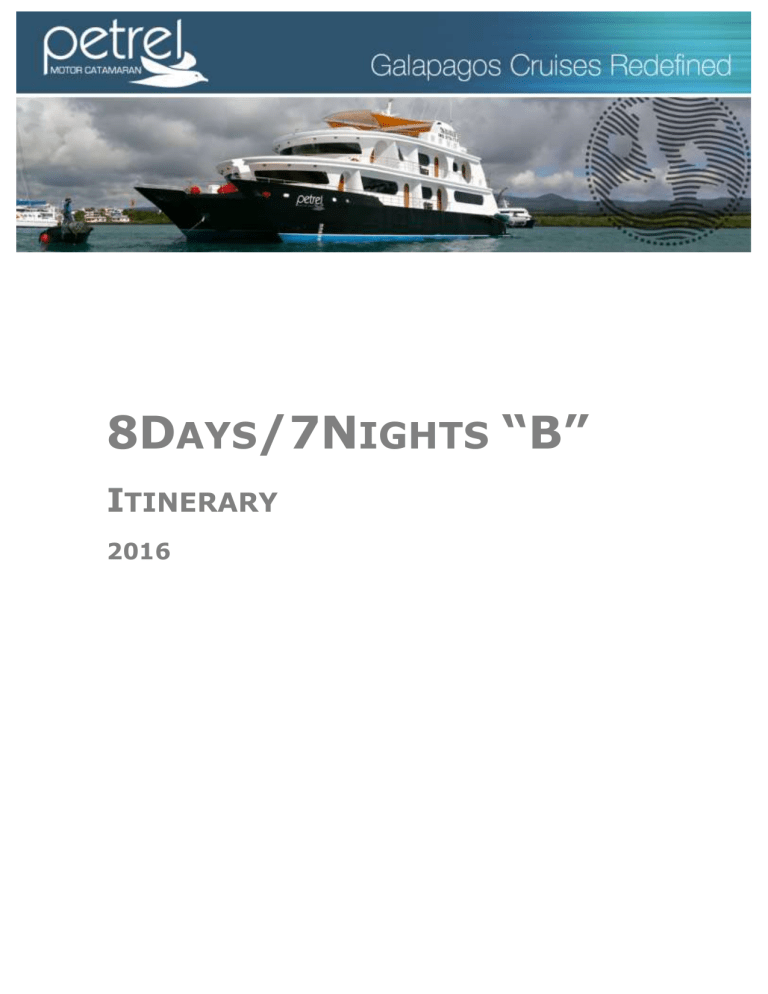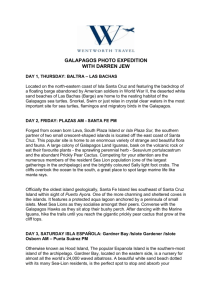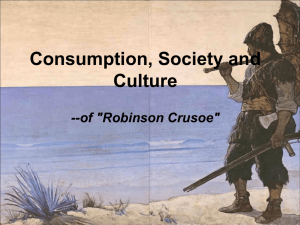8 Days / 7 Nights B Petrel Itinerary Outline

8D AYS /7N IGHTS “B”
I
TINERARY
2016
8 D
AYS
/ 7 N
IGHTS
B
P
ETREL
I
TINERARY
O
UTLINE
F
RIDAY
AM: Arrival to San Cristobal Airport - Transfer to Petrel
PM: San Cristobal Island - C.C. Jacinto Gordillo Giant Tortoise Breeding Ctr. / Interpretation Ctr.
S ATURDAY
AM: Espanola Island – Gardner Bay / Osborn Islet / Gardner Islet
PM: Espanola Island – Suarez Point
S
UNDAY
AM: Floreana Island - Devil’s Crown / Cormorant Point
PM: Floreana Island – Post Office Bay / Baroness Lookout Point
M
ONDAY
AM: Santa Cruz Island – C.C. Fausto Llerena Charles Darwin Research Station
PM: Santa Cruz Island - Highlands
T
UESDAY
AM: Santiago Island – Sullivan Bay
PM: Bartholomew Island – Pinnacle Rock
W
EDNESDAY
AM: Genovesa Island – Darwin Bay
PM: Genovesa Island – El Barranco (Prince Phillip’s Steps)
T HURSDAY
AM: Santiago Island – Egas Port
PM: Santiago Island – Buccaneer Cove / Espumilla Beach
F
RIDAY
AM: Santa Cruz Island – Carrion Point
PM: Transfer to Baltra Airport
T
ERMS TO
K
NOW
L ANDINGS – L ANDINGS ARE HOW YOU ARRIVE TO THE VISITOR SITES .
E ACH SITE IS VISITED BY
DINGHY , ALSO KNOWN AS ZODIAC OR PANGA .
P ANGA – P ANGA IS THE S PANISH TERM FOR DINGHY OR ZODIAC .
Y OU WILL HEAR THIS WORD OFTEN .
D RY L ANDING –U PON ARRIVAL TO THE VISITOR SITE YOU WILL NOT HAVE TO ENTER THE WATER WHEN
EXITING THE ZODIAC OR DINGHY .
W ET L ANDING – U PON ARRIVAL TO THE VISITOR SITE YOU WILL EXIT THE DINGHY BY ENTERING THE
WATER FIRST , THEN WALKING ASHORE .
N O L ANDING – T HERE WILL BE NO LANDING BECAUSE ACTIVITY WILL CONSIST OF PANGA RIDE OR
SNORKELING .
D INGHY R IDE – T HE DINGHY RIDE IS A SIMPLE RIDE ON THE WATER AROUND THE VISITOR AREA .
THIS IS DONE WHEN THERE IS NO LANDING PERMITTED OR TO GET A BETTER VIEW OF NEARBY WILDLIFE
OR LANDSCAPES .
P OSSIBLE A CTIVITIES – A LL ACTIVITIES ARE TO BE ULTIMATELY DECIDED BY THE GUIDE
CONSIDERING WEATHER , SEA CONDITIONS , AND OTHER FACTORS .
T HE ACTIVITIES LISTED IN ALL
ITINERARIES ARE THE FINAL DECISION MADE BY THE G ALAPAGOS NATIONAL PARK OFFICIALS WITH THE
BEST INTEREST OF THE ISLANDS IN MIND .
T HESE CANNOT BE ALTERED IN ANY WAY .
D
AY
1 (F
RIDAY
)
ARRIVAL TO SAN CRISTOBAL ISLAND (GALAPAGOS)
Assistance will be provided upon your arrival by a Petrel representative after passing through immigration and baggage claim. When ready, you will be transferred to the yacht. You will then be shown to your cabin where you will have some time to settle in before the welcome briefing and lunch.
San Cristobal Island – C.C. Jacinto Gordillo Giant Tortoise Breeding Ctr. / Interpretation Ctr.
San Cristobal Island: This is the fifth largest island in the Galapagos and lies farthest East. It is where Darwin first landed back in 1835 and where the first permanent settlements were founded. Today the main port Puerto Baquerizo Moreno is the capital of Galapagos and houses many government offices, the
Ecuadorian Navy, and an airport with daily flights to the mainland of Ecuador. Conservation challenges the island faces include invasive plants like blackberry and guayaba and insects like the blackfly.
Giant Tortoise Breeding Ctr. / Interpretation Ctr.: The Interpretation Center has been open to the public since 1998 and offers extensive information about the history of Galapagos, all ecosystems, geology, and flora and fauna. Giant tortoises are also bred here by the center and roam about in a seminatural habitat created by the centers employees. Within the center are meeting rooms, interpretational panels, auditoriums, exhibits, and much more.
Possible Activities: Walk
Difficulty: Easy
Type of Landing: Dry Landing
Highlights: Giant tortoises up close and roaming freely, exhibits of various stages of tortoise breeding, learn more about origin, evolution, natural habitat, and threats of introduced animals and plants.
D AY 2 (S ATURDAY )
Espanola Island – Gardner Bay/Osborn Islet/Gardner Islet
Espanola Island: Here lies the southernmost island in the Galapagos, as well as the oldest. It is estimated to be about four million years old. Because it is so far away from the other islands it has the most endemic species. It is a wonderful opportunity for some great photography of endemic bird species that are found only on Espanola and awesome landscapes created by millions of years of erosion.
Gardner Bay/Osborn Islet/Gardner Islet: Visit one of the best beaches in the Galapagos. The white sandy beach is home to a large colony of friendly and playful sea lions. Three different types of finches can be seen. The Espanola Mockingbird is very friendly, but probably looking for food. At one point in time, tourists must have given it water or food, which taught them bad habits. The site is also where green sea turtles will come to nest their eggs between January and March.
Possible Activities: Walk, Snorkel, Panga Ride
Difficulty: Easy/Moderate
Type of Landing: Wet Landing
Highlights: Espanola Mockingbird, longest beach in Galapagos, three species of Darwin’s finches, large colony of sea lions, occasional green sea turtles. Snorkel – coral fish, sea lions, and other marine life.
Suarez Point: This is a phenomenal site where you will get to see many of Espanola Island’s endemic species. The trail will pass by the only Waved Albatross breeding site. If you are lucky you might see a young albatross take off for its first flight for up to five years at sea. Older birds stay at sea for months at a time, only coming back to breed. They have the same mate for life and will meet each other each year, only here to reproduce. Other species that can be seen are marine iguanas that stay brightly colored year round, Galapagos doves, Nazca boobies, blue-footed boobies, swallow-tailed gulls, red-billed tropic birds, and Darwin finches.
Possible Activities: Hike
Difficulty: Moderate
Type of Landing: Dry Landing
Highlights: Only Waved albatross breeding site, blow hole on the point, Nazca boobies, swallow tailed gulls, red-billed tropic birds, three different species of finches, Galapagos doves, marine iguanas, sea lions.
D
AY
3 (S
UNDAY
)
Floreana Island – Devil’s Crown/Cormorant Point
Floreana Island: This Island is one of the most interesting when it comes to human history. The first Galapagos resident was an Irishman who lived on Floreana from 1807 to 1809. It is the site of the first post office within the islands created by whalers in the 1700’s. Later it became the first island to be colonized by Ecuadorians, but to this day is still very isolated. Surrounded by mystery, in the 1930’s various disappearances occurred and is thought to be because of tension between a baroness and her three servants who arrived after an already settled husband and wife, who gave birth to the first to be born in Galapagos and another couple of a doctor and female companion who lived of the land from their garden. The small population of today lives off the land with home grown farms and gets their water from rain filled ponds during the rainy season. There is one hotel with the only phone in the port of Velasco Ibarra where most residents live, the rest live up in the highlands. Transportation is limited and is only available every two weeks.
Devil’s Crown: Devil’s Crown is a visitor site that boasts the best snorkeling opportunities. Below the surface are amazing volcanic structures that have submerged over time. Hundreds of different colorful fish species can be found here among the coral reefs. Sharks, rays, sea turtles, hammer head sharks and sea lions are also common visitors. It is an underwater spectacle that cannot be missed.
Cormorant Point: Another fun and interesting visitor site. Two beaches can be visited and flamingoes can be seen wading through brackish lagoons looking for shrimp, which gives them their bright and vibrant colors. One of the beaches look green because of olivine crystals and the other is appropriately called Flour Beach a powdery white, made from fine pulverized coral.
Possible Activities: Snorkel, panga ride, hike
Difficulty: Easy/Moderate
Type of Landing: Wet Landing
Highlights: Devil’s Crown - a wide array of colorful fish species – king angel fish, balloon fish, yellow tail grunts, white-tipped sharks, hammerheads, eagle rays, sea turtles, sea lions and more. Cormorant Point – flamingoes, green olivine crystal beach, coral beach, pintail ducks, large-billed fly catchers, several finches, green turtle nesting area, and stilts.
Post Office Bay/Baroness Lookout Point
Post Office Bay: A completely human influential site, Post Office Bay is the first official post office created by passing whalers in the 1700’s. To this day visitors continue the tradition as many leave addressed messages on post cards in the barrel to be sent by future visitors while picking up post cards left behind by previous visitors to send when they return home. It is a fun exchangeable activity many visitors enjoy.
Baroness Lookout Point: On the northern part of the island, Baroness Lookout Point has a beautiful landscape and historic view. It was named after the supposed Austrian Baroness that was the subject of many mysterious disappearances and well-known stories of loathing by those on Floreana before her.
Possible Activities: Walk, kayak, panga ride, snorkel
Difficulty: Easy/Moderate
Type of Landing: Wet Landing
Highlights: Barrel Post Office – leave/pick up post cards, remnants of Norwegian settlement, beach, sea turtles, amazing landscapes. Snorkel – Sea turtles, corals, rays, colorful assortment of fish species.
D
AY
4 (M
ONDAY
)
Santa Cruz – C.C. Fausto Llerena Charles Darwin Research Station & Highlands
Santa Cruz Island: Today Santa Cruz is one of the most popular tourist sites. With a population of about 12,000 Galapagos natives, it has the longest paved road in the entire archipelago. One of the biggest conservation efforts is to eliminate all non-native plants and animals that are destroying native and endemic species on the island. There is no longer any volcanic activity but that does not mean there is no evidence.
Santa Cruz means holy cross, but it’s English name comes from the British vessel – Indefatigable.
Charles Darwin Research Station: The station conducts many different research projects and provides assistance to other researchers and governmental institutions and agencies, especially the
Galapagos National Park. Many of the results are later published online, in magazines, and popular scientific journals. The research station also plays a big part in educating the community and public schools in
Galapagos. There is also the longtime running Giant Tortoise restoration program that includes various stages of the giant tortoise from eggs, hatchlings and adults.
Possible Activities: Walk
Difficulty: Easy
Type of Landing: Dry
Highlights: See the latest advances in research at the Charles Darwin Research Station. Also see Giant
Tortoises and land iguanas.
Highlands: The Highlands of Santa Cruz is a very interesting site due to the rich wildlife, hills, ferns, volcanoes and lava tubes present. Exploring the lava tubes is a surreal and unique experience. Here you can see all the different agricultural zones that are present in the Galapagos in one place. The variety of birds makes this a bird watchers delight.
Possible Activities: Hike
Difficulty: Moderate
Type of Landing: Dry
Highlights: All Galapagos life zones, vermilion flycatcher, Darwin finch, yellow warblers, Galapagos rails, paint-billed crakes, short eared owls, wild Giant Tortoises.
D
AY
5 (T
UESDAY
)
Santiago Island – Sullivan Bay
Santiago Island: The second Island visited by Charles Darwin was originally named after
England’s King James the second. The island was a good source of salt, water and food for whalers and buccaneers passing. There was a salt mine inland that was used to salt fish and tortoise meat. Land iguanas used to populate the island but are now extinct. From Darwin’s own notes he wrote that land iguanas were thriving quite well since there was no place to even pitch a tent. Santiago Island today is now one of the most visited islands.
Sullivan Bay: Sullivan Bay is a satellite island of Santiago. This is one of the best places to see the Galapagos fur seal. There is not much wildlife to see here, but the old lava formations are quite a site to see with tuff cones, pyroclastic cones, and other volcanic landscapes.
Possible Activities: Hike and snorkel
Difficulty: Moderate
Type of Landing: Dry Landing
Highlights: Various volcanic landscapes and formations.
Bartholomew Island – Pinnacle Rock
Bartholomew Island: Bartholomew is another satellite island that derives from Santiago Island.
It is home of the famous Pinnacle Rock and is named after James Sullivan, a friend of Charles Darwin who was also aboard the HMS Beagle. Of all the islands, this is the most photographed and is also featured in the 2003 movie “Master and Commander”.
Pinnacle Rock: Pinnacle rock is a volcano cone formed by magma expelled by an underwater volcano. The sea cooled the hot lava and as it exploded from contact, the pieces formed together this huge rock of many, many layers of basalt. The huge rock also has a beach where a small population of green sea turtles will nest. Galapagos penguins gather here and swimming can offer beautiful sights of colorful schools of fish and curious sea lions.
Possible Activities: Hike, snorkel, panga ride
Difficulty: Easy
Type of Landing: Wet Landing
Highlights: Galapagos penguins, Pinnacle rock, swimming, awesome photography opportunities. Snorkel –
Sea lions, rays, sea turtles, sharks, many different fish.
D
AY
6 (W
EDNESDAY
)
Genovesa Island – Darwin Bay
Genovesa Island: This horse-shoe shaped island was formed by the eruption of a shield volcano with large slopes formed by gradual lava flows. It is known as “Bird Island” due to the wide variety of birds that can be seen. The only reptile on the entire island is the marine iguana and it is one of the very few places red-footed boobies gather in one large mass.
Darwin Bay: Darwin Bay is the result of the shield volcano where one of the sides of the caldera collapsed after years of erosion. It is one of the places in the Galapagos where red-footed boobies can be guaranteed to be seen. Over 200,000 red-footed boobies are estimated to be living in the trees and bushes of Genovesa.
Possible Activities: Hike, kayak, panga ride, and snorkel
Difficulty: Easy/Moderate
Type of Landing: Wet Landing
Highlights: Nazca boobies, red-footed boobies, swallow-tailed gulls, mangroves. Snorkeling – various sharks, colorful fish, sea turtles, sea lions, occasional rays.
Genovesa Island – El Barranco (Prince Phillip’s Steps)
El Barranco: Better known as Prince Phillip’s Steps, a steep and rocky path leads up to a cliff with a marvelous view. There is also a Palo Santa forest that is home to nesting red-footed boobies and other birds.
Possible Activities: Hike, kayak, panga ride, and snorkel
Difficulty: Moderate
Type of Landing: Dry Landing
Highlights: Spectacular view, red-footed boobies, wedge-romped storm petrels, Galapagos doves, shorteared owls, Palo Santo forest. Snorkel – fish, sea turtles, rays, sharks, and sea lions.
D AY 7 (T HURSDAY )
Santiago Island – Egas Port
Egas Port: Egas port is also known as James Bay. It is home to quick footed Galapagos lava lizards, Galapagos fur seals along the grottos and tide pools and is a great snorkeling site.
Possible Activities: Hike and Snorkel
Difficulty: Easy/Moderate
Type of Landing: Wet Landing
Highlights: Fur seals, sea lions, tidal pools and grottos, Galapagos hawk, salt water lagoon with flamingoes.
Snorkeling – sea turtles, rays, sharks and amazing underwater geological formations.
Santiago Island – Buccaneer Cove/Espumilla Beach
Buccaneer Cove: This cove is better known for excellent snorkeling opportunities and was once known as a refuge for British buccaneers or pirates. The underwater formations are amazing and many different species of fish gather here.
Possible Activities: Hike, kayak, panga ride and snorkel
Difficulty: Easy
Type of Landing: Wet Landing
Highlights: Historical pirate/buccaneer shelter site. Snorkeling – sea turtles, rays, sharks and amazing underwater geological formations.
Espumilla Beach: We will also visit Espumilla Beach where marine iguanas lounge and the Sally-
Lightfoot crabs attract the hunting herons and perform the dance of predator and prey right before your eyes. Snorkeling is highly recommended as you could find yourself face to face with an octopus, moray eel, shark, or a variety of other species of tropical fish.
Possible Activities: Snorkeling and swimming, short walk along the beach (less than 0.6 mi / 1 km)
Difficulty: Easy
Type of Landing: Wet Landing
Highlights: Snorkeling, sea birds, historical site, and rock formations.
D
AY
8 (F
RIDAY
)
Santa Cruz Island – Carrion Point
Carrion Point: There is no place to land here so either a panga ride or snorkeling will take place.
It is a sheltered lagoon with beautiful turquoise water on the Northern coast of Santa Cruz at the entrance of the Itabaca Channel.
Possible Activities: Panga ride and snorkel
Difficulty: Easy/Moderate
Type of Landing: No Landing
Highlights: Various species of fish, white-tipped reef sharks, rays, and sea turtles.
Transfer to Baltra Airport
Your cruise has officially come to an end. We hope you enjoyed your Galapagos Cruise! We will now transfer you to your scheduled departure from Baltra Airport to mainland Ecuador. Safe travels!
I MPORTANT :









